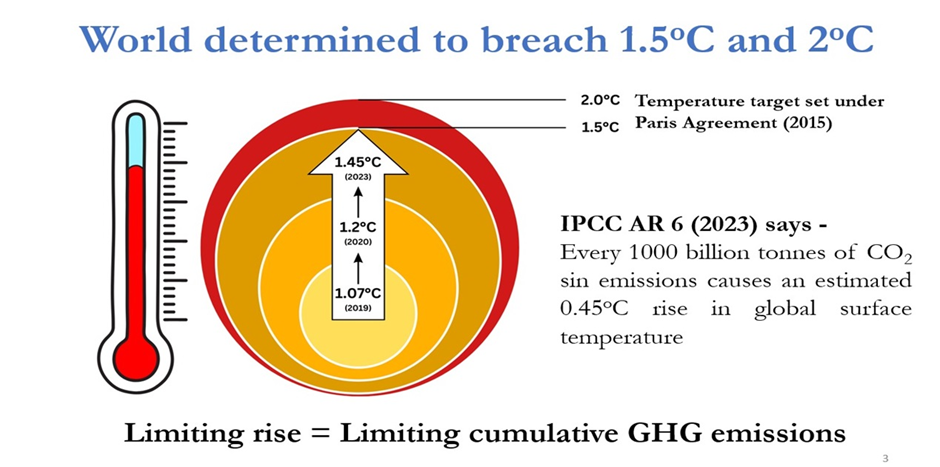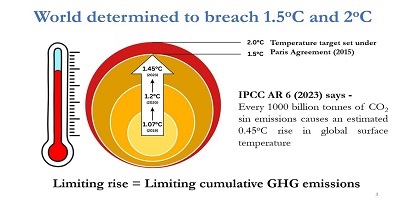Context-
The 1990s were a time of global change. The fall of the Berlin Wall led to Francis Fukuyama arguing in "The End of History and the Last Man" that Western liberal democracy had triumphed, leaving no room for further development in the narrative. This period saw the emergence of significant global environmental agreements at the 1992 Rio Earth Summit, such as the United Nations Framework Convention on Climate Change (UNFCCC), the Convention on Biological Diversity (CBD), and the Forest Principles.
In India, the balance of payments crisis, frequent changes in government, reorientation of economic policies, and its place in the world influenced its policies. Post-Rio, India's Ministry of Environment and Forests established divisions for climate change and biodiversity.
Global GHG Emissions and India's Contribution
According to the Intergovernmental Panel on Climate Change (IPCC) 6th Assessment Report, global net anthropogenic GHG emissions were 59 ± 6.6 GtCO2eq in 2019. Developed countries, with only 16% of the world's population, were responsible for 74% of excess resource use from 1970 to 2017. In contrast, India, among other developing countries, stayed within sustainability limits.
In 2019, India’s gross GHG emissions were 3.1 billion tonnes of CO2eq, and net emissions were 2.6 billion tonnes of CO2eq. India's emissions are significantly lower in both absolute and per capita terms compared to developed countries, reflecting its equitable share.

Determinants of India’s Climate Policy

Geography
India, the 7th largest country, covers an area of 3.28 million km², accounting for just 2.4% of the world's area and 4% of its freshwater resources. It is one of the 17 mega-biodiverse countries, boasting four biodiversity hotspots, ten bio-geographic zones, and 22 agro-biodiversity hotspots. India's civilization and economy have developed in harmony with its six distinct seasons: Vasant (Spring), Grishma (Summer), Varsha (Monsoon), Sharad (Autumn), Hemant (Pre-Winter), and Shishir (Winter). However, recent decades have seen climate change disrupt this harmony, leading to unpredictable weather patterns and negative consequences for both nature and society.
Population
India’s population of 1.4 billion is viewed as an asset and a source of strength. The country hosts 7-8% of the world's documented species, encompassing over 45,500 plant species, 91,000 animal species, and countless undiscovered microbes. With a low human-to-land ratio of 0.0021 square kilometers per person, India necessitates a nuanced approach to sustainability, integrating land and water management. India's forests, home to 70% of the global tiger population, more than 60% of Asian elephants, and the entire population of Asiatic lions, are crucial in this regard. In 2019, these forests and tree cover removed approximately 20% of the country’s total CO2 emissions.
Impacts
Climate change has presented persistent challenges to India. According to the Global Climate Risk Index 2020, India ranks as the fifth most affected nation by climate change, grappling with an increasing frequency of extreme weather events. A 2018 World Bank report forecasts that India could incur a loss of 2.8% of its GDP due to rising temperatures and shifting monsoon rainfall patterns. Additionally, a study by Kotz et al. (2024) predicts that the global economy could lose about 19% of its income in the next 25 years due to climate change, with countries in Africa and South Asia suffering the most despite being the least responsible for the problem.
Worldview
India’s worldview is shaped by its ancestral traditions of living in harmony with nature. Ancient texts like the Vedas express deep respect for the Earth. For instance, the Prithvi Sukta of the Atharva Veda states, The Earth is our Mother, and we are her children. This intrinsic connection with nature contrasts with Western scientific perspectives, which often depict forests and trees merely as carbon sinks. In India, forests are revered and worshipped, providing not only provisioning and regulating services but also supporting cultural ecosystem services.
Gandhi’s ideals of trusteeship and moderation further reinforce India’s environmental stance. His belief that the Earth provides enough to satisfy everyone’s needs, but not greed, underscores the country's emphasis on sustainable lifestyles. The Ministry of Environment, Forest and Climate Change's logo, "Nature Protects if She is Protected," reflects this reverence for nature and a commitment to conservation.
Actions
India’s actions on climate change are evidence-based and scientifically driven. Despite its minimal historical contribution to global GHG emissions, India has taken significant domestic and international steps to combat climate change. The country has established global institutions like the International Solar Alliance, the Coalition for Disaster Resilient Infrastructure, and the Global Biofuels Alliance. Domestically, India has focused on transitioning to renewable energy and reducing the emission intensity of its GDP by 33% from 2005 to 2019.
India’s per capita annual emissions are about a third of the global average, yet it remains committed to proactive climate action. This commitment stands in contrast to developed countries, which have shown inconsistency in their climate commitments, such as the United States' withdrawal and rejoining of the Paris Agreement.
Evolution of Climate Policy
India's climate policy prioritizes inclusive growth, poverty eradication, and adherence to UNFCCC principles. It is characterized by clarity, consistency, and coordination across multiple sectors. India's National Action Plan on Climate Change (2008) and efforts involving 23 ministries highlight its comprehensive approach.
India is a global leader in climate action, adding confidence and convenient action to its policy. The Ministry of Environment, Forest and Climate Change and global initiatives underscore this leadership. However, India cannot address climate change alone. Developed countries must honor their commitments to provide adequate climate finance and technology transfer.
International Cooperation and Equity
Despite India's significant efforts, the journey towards climate action cannot be undertaken alone. Developed countries, having historically over-appropriated from the global carbon budget, owe a carbon debt to India and the global South. These countries must honor their commitments under the UNFCCC to provide adequate climate finance and technology transfer. This support is crucial for developing countries to adapt to and mitigate the impacts of climate change.
Adaptation and Mitigation
In India and other developing countries, adaptation to climate change is a paramount concern. The impacts of climate change disproportionately affect these regions, which have the least resources to cope with the consequences. India’s climate policy emphasizes the need for global cooperation and support to enhance resilience and adaptation capacities.
Sustainable Development
Development and environmental sustainability are two sides of the same coin and must be pursued together for holistic development. India’s model of sustainable development, which integrates environmental conservation with economic and social progress, serves as a blueprint for other developing countries. The "Vasudhaiva Kutumbakam" principle – One Earth, One Family, One Future – underscores the need for a collective, inclusive approach to solving global environmental challenges.
Conclusion
India’s climate policy is a testament to its commitment to sustainable development and global environmental stewardship. Rooted in ancient wisdom and modern scientific evidence, India’s approach emphasizes equity, inclusivity, and proactive action. By balancing development and environmental protection, India offers a viable model for the global South, advocating for a cooperative, realistic approach to addressing climate change.
The world must embrace India’s ethos of "Vasudhaiva Kutumbakam" to effectively tackle the collective action problem of climate change. We can ensure a stable and prosperous future for all through global cooperation, equitable resource sharing, and sustainable lifestyles. India’s leadership in climate action provides a hopeful path forward, challenging the developed world's narratives and emphasizing the need for a new, sustainable developmental paradigm.
|
Probable Questions for UPSC Mains Exam-
|
Source- VIF







